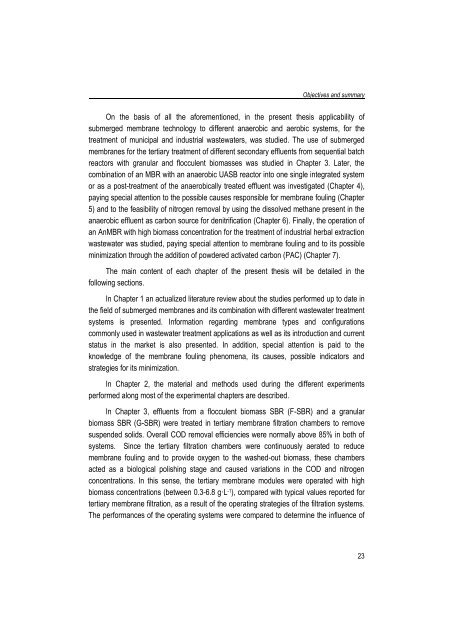Combining submerged membrane technology with anaerobic and ...
Combining submerged membrane technology with anaerobic and ...
Combining submerged membrane technology with anaerobic and ...
You also want an ePaper? Increase the reach of your titles
YUMPU automatically turns print PDFs into web optimized ePapers that Google loves.
Objectives <strong>and</strong> summaryOn the basis of all the aforementioned, in the present thesis applicability of<strong>submerged</strong> <strong>membrane</strong> <strong>technology</strong> to different <strong>anaerobic</strong> <strong>and</strong> aerobic systems, for thetreatment of municipal <strong>and</strong> industrial wastewaters, was studied. The use of <strong>submerged</strong><strong>membrane</strong>s for the tertiary treatment of different secondary effluents from sequential batchreactors <strong>with</strong> granular <strong>and</strong> flocculent biomasses was studied in Chapter 3. Later, thecombination of an MBR <strong>with</strong> an <strong>anaerobic</strong> UASB reactor into one single integrated systemor as a post-treatment of the <strong>anaerobic</strong>ally treated effluent was investigated (Chapter 4),paying special attention to the possible causes responsible for <strong>membrane</strong> fouling (Chapter5) <strong>and</strong> to the feasibility of nitrogen removal by using the dissolved methane present in the<strong>anaerobic</strong> effluent as carbon source for denitrification (Chapter 6). Finally, the operation ofan AnMBR <strong>with</strong> high biomass concentration for the treatment of industrial herbal extractionwastewater was studied, paying special attention to <strong>membrane</strong> fouling <strong>and</strong> to its possibleminimization through the addition of powdered activated carbon (PAC) (Chapter 7).The main content of each chapter of the present thesis will be detailed in thefollowing sections.In Chapter 1 an actualized literature review about the studies performed up to date inthe field of <strong>submerged</strong> <strong>membrane</strong>s <strong>and</strong> its combination <strong>with</strong> different wastewater treatmentsystems is presented. Information regarding <strong>membrane</strong> types <strong>and</strong> configurationscommonly used in wastewater treatment applications as well as its introduction <strong>and</strong> currentstatus in the market is also presented. In addition, special attention is paid to theknowledge of the <strong>membrane</strong> fouling phenomena, its causes, possible indicators <strong>and</strong>strategies for its minimization.In Chapter 2, the material <strong>and</strong> methods used during the different experimentsperformed along most of the experimental chapters are described.In Chapter 3, effluents from a flocculent biomass SBR (F-SBR) <strong>and</strong> a granularbiomass SBR (G-SBR) were treated in tertiary <strong>membrane</strong> filtration chambers to removesuspended solids. Overall COD removal efficiencies were normally above 85% in both ofsystems. Since the tertiary filtration chambers were continuously aerated to reduce<strong>membrane</strong> fouling <strong>and</strong> to provide oxygen to the washed-out biomass, these chambersacted as a biological polishing stage <strong>and</strong> caused variations in the COD <strong>and</strong> nitrogenconcentrations. In this sense, the tertiary <strong>membrane</strong> modules were operated <strong>with</strong> highbiomass concentrations (between 0.3-6.8 g·L -1 ), compared <strong>with</strong> typical values reported fortertiary <strong>membrane</strong> filtration, as a result of the operating strategies of the filtration systems.The performances of the operating systems were compared to determine the influence of23
















